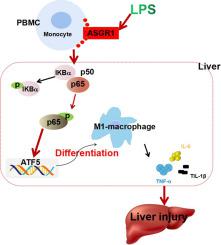宗旨
肝脏是败血症引起的损伤的关键器官,大约 40% 的肝损伤是由败血症引起的。在肝损伤期间,单核细胞向巨噬细胞的分化是一个关键事件,因为它会导致免疫反应的调节。Asialoglycoprotein 受体 1 (ASGR1) 富含外周血单核细胞 (PBMC) 的经典单核细胞。我们旨在探讨 ASGR1 对单核细胞向巨噬细胞分化的影响以及脓毒症引起的肝损伤的调节作用。
主要方法
利用 PMA 和 30% L929 细胞条件培养基诱导的 ASGR1 敲低/过表达 THP-1 细胞和小鼠骨髓源性巨噬细胞 (BMDM),分别检测 ASGR1 对单核细胞至巨噬细胞分化的影响和分子机制。通过流式细胞术和实时定量 PCR 评估分化特异性因子的表达。RNA 测序 (RNA-seq) 分析揭示了 ASGR1 对单核细胞到巨噬细胞分化的影响。此外,通过蛋白质印迹检查了分化特异性因子 ATF5 和 NF-κB 通路。co-IP 进一步检查了 ASGR1 和 ATF5 之间的相互作用。最后,LPS 诱导的 ASGR1 敲低小鼠脓毒症用于研究 ASGR1 对单核细胞至巨噬细胞分化、肝损伤和存活的影响。
主要发现
ASGR1 通过上调 CD68、F4/80 和 CD86 促进单核细胞向巨噬细胞的分化。此外,inhibited-ASGR1 通过在体外和体内抑制 NF-κB 和 IKBa 的磷酸化来降低 ATF5 的表达。ASGR1 敲除小鼠抑制 PBMC 中的 Ly6C hi炎性单核细胞,并抑制肝脏中 CD45 + CD11b hi F4/80 + Ly6C lo单核细胞衍生的巨噬细胞和 CD45 + CD11b + F4/80 + Ly6C +炎性巨噬细胞。它还抑制了 IL-1β、IL-6、TNF-α 的水平,减轻了肝损伤并提高了脓毒症后的存活率。
意义
ASGR1 是败血症引起的肝损伤和存活的负调节因子。
 "点击查看英文标题和摘要"
"点击查看英文标题和摘要"
ASGR1 promotes liver injury in sepsis by modulating monocyte-to-macrophage differentiation via NF-κB/ATF5 pathway
Aims
Liver is a pivotal organ for sepsis-induced injury and approximately 40 % of liver injury results from sepsis. During hepatic injury, monocyte-to-macrophage differentiation is a key event because it results in the regulation of immune response. Asialoglycoprotein receptor 1 (ASGR1) is enriched in classical monocyte of peripheral blood mononuclear cells (PBMCs). We aimed to explore the effect of ASGR1 on monocyte-to-macrophage differentiation and the modulation of sepsis-induced liver injury.
Main methods
ASGR1-knockdown/overexpression THP-1 cells and mice bone marrow-derived macrophages (BMDMs) induced by PMA and 30 % L929-cell conditioned medium were utilized to test the impact of ASGR1 on monocyte-to-macrophage differentiation and molecular mechanism respectively. Expression of differentiation specific factors were assessed via flow cytometry and real-time quantitative PCR. RNA-sequencing (RNA-seq) analysis revealed the effect of ASGR1 on monocyte-to-macrophage differentiation. Further, differentiation specific factors ATF5 and NF-κB pathways were examined via Western blot. The interaction between ASGR1 and ATF5 was further examined by co-IP. Finally, LPS-induced ASGR1-knockdown mice sepsis was used to investigate the effect of ASGR1 on monocyte-to-macrophage differentiation, liver injury and survival.
Key findings
ASGR1 promoted monocyte-to-macrophage differentiation via up-regulating CD68, F4/80 and CD86. Additionally, inhibited-ASGR1 decreased ATF5 expression by suppressing phosphorylation of NF-κB and IKBa in vitro and in vivo. ASGR1-knockdown mice suppressed Ly6Chi inflammatory monocytes in PBMCs, and restrained CD45+CD11bhiF4/80+Ly6Clo monocyte-derived macrophages and CD45+CD11b+F4/80+Ly6C+ inflammatory macrophages in livers. It also suppressed the level of IL-1β, IL-6, TNF-α and alleviated liver injury and improved survival after sepsis.
Significance
ASGR1 is a negative regulator for sepsis-induced liver injury and survival.



































 京公网安备 11010802027423号
京公网安备 11010802027423号